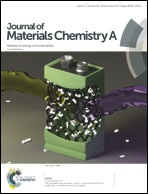Highly stable perovskite solar cells with all-inorganic selective contacts from microwave-synthesized oxide nanoparticles†
Abstract
Although perovskite solar cells have achieved extremely high performance in just a few years, their device stability and fabrication cost are still of great concern. For inverted p–i–n perovskite solar cells, the commonly used electron-transporting layers are C60 and PCBM, which have stability issues and are very expensive. Here, we report a novel and highly stable perovskite solar cell using an inorganic electron-transporting layer made of microwave-assisted solution-processed indium-doped zinc oxide (IZO) nanoparticles. With NiO as the hole-transporting layer, the perovskite solar cells with all-inorganic selective contacts demonstrate a decent power conversion efficiency of over 16%. More importantly, the IZO-based perovskite solar cells demonstrate impressive long-term stability under air or light-soaking conditions. With encapsulation, our device retained 85% of the initial power conversion efficiency after 460 hours of light soaking. This result reveals that good device performance, low fabrication cost and impressive light-soaking stability can be realized simultaneously by employing facile microwave-synthesized oxides (IZO and NiO in this work) as inorganic selective contacts.



 Please wait while we load your content...
Please wait while we load your content...